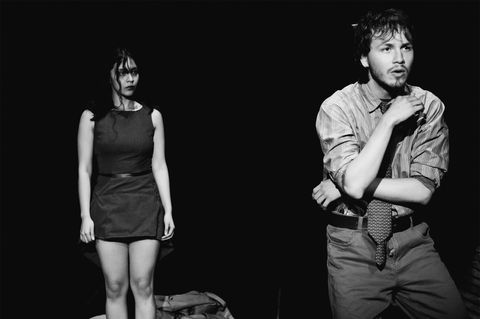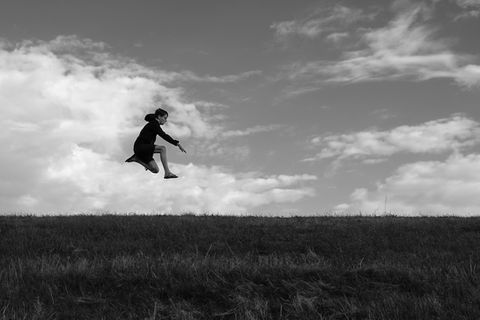
REPRESENTING THE PEOPLE
February 26, 2021
INTERVIEW
PHOTOGRAPHY Camille J. Wheeler
INTERVIEW Karin Svadlenak
Camille J. Wheeler is originally from farm country in the South Plains of Texas. It was her mother, a teacher in journalism and English, who taught her the tools of writing and editing. It was only later, after having been a reporter, feature writer and page designer, among other editorial tasks in the newspaper industry, that Camille fell in love with photography. Now living in Austin, Texas, Camille started traversing the city with a camera, finding her path forward as a photojournalist, often documenting the homeless, but also more generally life in the streets. Her photography is always respectful, and she engages directly with her photographic subjects, often creating long term relationships and documenting the people she meets over time.

“My path to the homeless community began by observing the segregated populations in Austin — people who are segregated by disability/non-disability, people who are segregated by race, and people who are segregated by economic and housing status. The highest compliment I have received from members of the homeless community is that I represent the people.”
IN CONVERSATION WITH CAMILLE J. WHEELER
THE PICTORIAL LIST: Camille please tell us about yourself. How did you become interested in photography and in photojournalism?
CAMILLE J. WHEELER: I was born in Lubbock, on the South Plains of Texas, where I grew up in a farming and ranching family. My mother was my high school English and journalism teacher at the tiny country school I attended, and she gave me the tools I needed for my future as a writer and an editor.
I worked for 21 years in the newspaper industry, including with the Austin American-Statesman, but I never picked up a camera on the job. I wore many hats, including that of reporter, feature writer, page designer, and assigning/project editor, and I spent countless hours in the photo lab looking through a loop and selecting images for stories. I loved hanging out with photographers — I just didn’t know that I was one myself.
I have lived in Austin for nearly three decades now. My background here also includes an associate editor tenure with a magazine, where I continued to build relationships with photographers and occasionally held a camera myself.
In April 2014, I borrowed a camera to document a mixed-ability dance performance in downtown Austin in which my spouse, Donna, participated. It was a thrilling experience, and on that day, I realized I was a photographer. I bought my own camera and started traversing the city, finding my path forward as a photojournalist and connecting the most with those who experience discrimination and who don’t fit into the conventional norms of society.
TPL: You report a lot about the homeless community in Austin. How did this come about? What drives you?
CJW: My path to the homeless community began by observing the segregated populations in Austin — people who are segregated by disability/non-disability, people who are segregated by race, and people who are segregated by economic and housing status.
In 2014, I started photographing the world of mixed-ability dance — improvisational work that empowers people of all abilities to embrace dancing in their own unique way. I also began documenting Black Lives Matter protests and exploring the historic African-American and Latino neighborhoods of East Austin.
Each new experience put me a step closer to the heart of the homeless population, in downtown Austin. In February 2016, I took my first portraits of people in this community. I began interviewing and reporting, gathering threads of stories.
Conversations came without filters. I found that incredibly refreshing. When people realized I meant what I said, that I wanted to sit and listen, they opened up and started talking. So what drives me, even more so now, is this unbridled desire to tell the stories of the beautiful and complicated souls I meet on the streets. And doing so with the combined tools of my camera, notepad, and voice recorder? That’s pure magic.
TPL: Do you have any favourite artists or photographers you would like to share with us, and the reason for their significance?
CJW: I draw inspiration from so many photographers and artists. To name two, I greatly admire portrait photographer Robert Bergman, who shoots with available light, and Khalik Allah, a New York–based photographer and filmmaker who shoots film at night in Harlem, also utilizing the light already present.
My favorite artist is James Turrell: a revolutionary light installation artist whose work is light, interacting with individuals in precisely made spaces that isolate the light and allow people to form relationships with it as a physical presence.
TPL: What happens when you go out with your camera? Do people respond positively to you, or do you sometimes get negative reactions? If yes, how do you handle it?
CJW: I normally am shy. But when I gather my photo gear and head downtown, I become transformed. People on Sixth Street tell me I constantly smile. That I exude good energy. I sometimes find this hard to believe, knowing that I can brood and circle the drain with the best of them, but I enjoy wonderful interactions on almost every outing. Because I smile so much, people smile back. Because I’ve gotten to know so many people, I often find myself surrounded by folks who just want to talk and catch up. From the start, I vowed to document people with dignity and respect - to avoid stealth shooting. To be transparent. I think people know this about me and respect me.
It’s funny. Every so often, I feel the urge to honor classic street photography - to take candid shots in the tradition of such greats as Vivian Maier, Helen Levitt, and Garry Winogrand. But almost every time I try, I fail. I’ll see a fascinating character on the other side of the street and say dang it, I have to go meet this person. And so it goes.
The highest compliment I have received from members of the homeless community is that I represent the people.
For sure, I have had negative reactions, and I have been scared on a few occasions. If someone gets upset with me, I try to quickly read the situation. Often, that means simply walking away, which I have learned is a form of respect. People have a right to their privacy and their space.
TPL: When you take pictures, do you usually have a concept in mind of what you want to shoot, or do you let the images just "come to you", or is it both?
CJW: I rarely have a concept of what I want to shoot other than I want to capture someone’s essence. My photos are determined by my interactions, which is an unpredictable strategy, to say the least. But for me, it works. When I meet someone, or reconnect with someone, the process starts naturally with conversation. Then, as we grow comfortable with each other, and with permission, I start taking photos, sometimes moving in so close that the lens is maybe one or two inches from the person’s eyes. This requires great trust, from both of us.
Conversations came without filters. I found that incredibly refreshing. When people realized I meant what I said, that I wanted to sit and listen, they opened up and started talking.

TPL: Does the equipment you use help you in achieving your vision in your photography? What camera do you use? Do you have a preferred lens/focal length?
CJW: For about two years now, I’ve shot with a Fuji X-T3 and a 23mm f1.4 lens, which seems to be near perfect for street photography. It’s a super sharp lens that’s just wide enough to capture extra background and context. I used to shoot exclusively with a Sony 50mm lens, and I’m thinking of adding the Fuji equivalent to my bag. It’s how I learned to shoot street portraits — it forced me to get physically close to people. I occasionally shoot with a zoom lens, but I prefer fixed lenses for portrait work.
TPL: What are some of your goals as a photographer/photojournalist? Where do you hope to see yourself in five years?
CJW: In five years, I’d dearly love to be in the middle of a book project about the messy and authentic relationships I have built with people on the streets.
Specifically, I am inspired by the work of the late documentary photographer Mary Ellen Mark. She returned again and again to the same subjects, establishing trust and building intimate relationships with homeless youth in a project that ultimately produced Streetwise, a 1984 documentary film and a 1988 book by the same name.
In that similar vein, I want to chronicle people as I have known them through the years, documenting the chapters of their lives.
TPL: Are there any special projects you are currently working on that you would like to let everyone know about?
CJW: Upon invitation, I recently submitted hundreds of my images of the homeless population to the Austin History Center for the creation of a photographs catalog. I am honored to be working with the AHC. It is deeply important to me to record the histories and the lives of those experiencing homelessness in Austin. I am excited about adding to this catalog and involving the members of the homeless community in the process.
TPL: When I am not out photographing, I (like to)…
CJW: I love all things outdoors - hiking, biking, and planning my next getaway to the Big Bend region in far West Texas. I love wildlife and nature, and that, of course, involves photography! I also love music and indie films and poring over the collection of art and photography books that Donna and I continue to stack up to impossibly tall heights in our small home.

Camille J. Wheeler has used her passion for photography as a way to document and share the stories of the people in her community. Through her photos, Camille has shown us the power of storytelling and respect in photojournalism. To see more of Camille's important work and join her in advocating for social justice, visit her website today.































